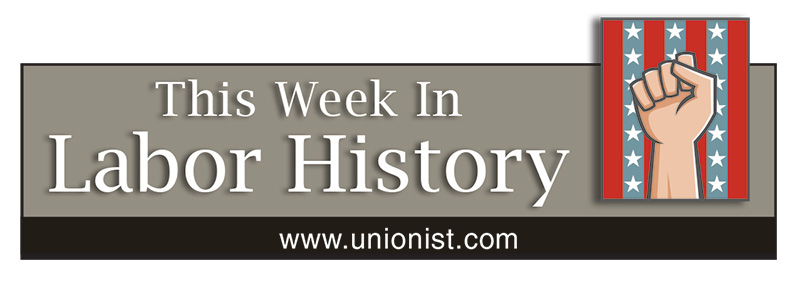This week in labor history: May 22-28

MAY 22
1895 – Eugene V. Debs imprisoned in Woodstock, Ill., for role in Pullman strike.
1920 – Civil Service Retirement Act of 1920 gives federal workers a pension.
1964 – President Lyndon B. Johnson announces the goals of his Great Society social reforms: to bring “an end to poverty and racial injustice” in America.
MAY 23
1903 – An estimated 100,000 textile workers, including more than 10,000 children, strike in the Philadelphia area. Among the issues: 60-hour workweeks, including night hours, for the children.
1934 – The Battle of Toledo begins today: a five-day running battle between roughly 6,000 strikers at the Electric Auto-Lite company of Toledo, Ohio, and 1,300 members of the Ohio National Guard. Two strikers died and more than 200 were injured.
1946 – U.S. railroad strike starts, later crushed when President Truman threatens to draft strikers.
MAY 24
1883 – After 14 years of construction and the deaths of 27 workers, the Brooklyn Bridge over New York’s East River opens. Newspapers call it “the eighth wonder of the world.”
1995 – Some 2,300 members of the United Rubber Workers, on strike for 10 months against five Bridgestone-Firestone plants, agree to return to work without a contract. They had been fighting demands for 12-hour shifts and wage increases tied to productivity gains.
MAY 25
1886 – Philip Murray is born in Scotland. He went on to emigrate to the U.S., become founder and first president of the United Steelworkers of America, and head of the Congress of Industrial Organizations (CIO) from 1940 until his death in 1952.
1936 – The notorious 11-month Remington Rand strike begins. The strike spawned the “Mohawk Valley (NY) formula,” described by investigators as a corporate plan to discredit union leaders, frighten the public with the threat of violence, employ thugs to beat up strikers, and other tactics. The National Labor Relations Board termed the formula “a battle plan for industrial war.”
1962 – The AFL-CIO begins what is to become an unsuccessful campaign for a 35-hour workweek, with the goal of reducing unemployment. Earlier tries by organized labor for 32- or 35-hour weeks also failed.
MAY 26
1824 – Men and women weavers in Pawtucket, R.I., stage nation’s first “co-ed” strike.
1937 – Some 100,000 steel workers and miners in mines owned by steel companies strike in seven states. The Memorial Day Massacre, in which 10 strikers were killed by police at Republic Steel in Chicago, took place four days later, on May 30.
1937 – Ford Motor Co. security guards attack union organizers and supporters attempting to distribute literature outside the plant in Dearborn, Mich., in an event that was to become known as the “Battle of the Overpass.” The guards tried to destroy any photos showing the attack, but some survived—and inspired the Pulitzer committee to establish a prize for photography.
MAY 27
1935 – The U.S. Supreme Court declares the Depression-era National Industrial Recovery Act to be unconstitutional, about a month before it was set to expire.
1959 – The CIO-affiliated Insurance Workers of America merges with its AFL counterpart, the Insurance Agents International Union to form the Insurance Workers International Union. The union later became part of the United Food and Commercial Workers.
MAY 28
1835 – The Ladies Shoe Binders Society formed in New York.
1912 – Fifteen women were dismissed from their jobs at the Curtis Publishing Company in Philadelphia for dancing the Turkey Trot. They were on their lunch break, but management thought the dance too racy.
1946 – At least 30,000 workers in Rochester, N.Y., participate in a general strike in support of municipal workers who had been fired for forming a union.
(Compiled by David Prosten, founder of Union Communication Services)


Leave a Reply